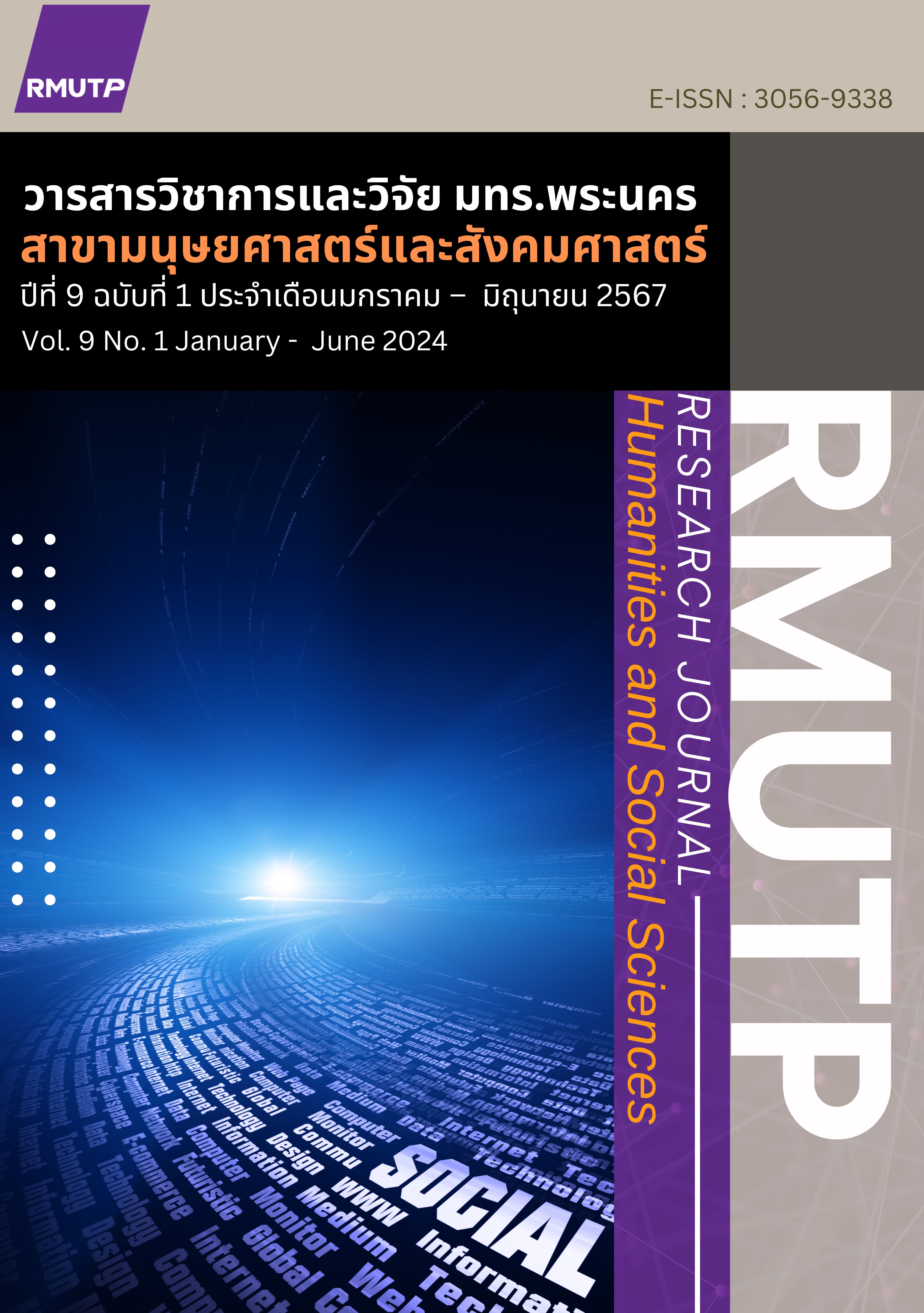Attitudes Affecting Vegetable Consumption Behavior of Students of Ban Cheyaw School, Narathiwat Province
Main Article Content
Abstract
The objectives of this research were (1) study students' attitudes toward eating vegetables, (2) study behavior Vegetable consumption of students, (3) compare the attitudes of students regarding the consumption of vegetables with their demographic features, (4) compare the consumption of vegetables among students with their demographic factors, and (5) study the attitudes that influence students' vegetable consumption of Ban Cheyaw School, Narathiwat Province. This research was quantitative research using a questionnaire to get information from a representative student population. The G*power application was utilized to calculate samples using Linear Multiple Regression: Fixed Model, Single Regression Coefficient, and specific sample selection for 104 students in Grades 1-6 at Ban Cheyaw School in Narathiwat Province. Statistics used in the research include mean, standard deviation, t-test, one-way analysis of variance, and simple linear regression analysis. The results of this research showed that: (1) students' attitudes toward eating vegetables were moderate (=3.37); and 2. students' vegetable consumption behavior was moderate (
=3.39). The hypothesis testing's findings showed that: The results of the comparison between students' attitudes toward the consumption of vegetables and demographic variables revealed that gender differences in attitudes about the intake of vegetables and the attitudes of different study grade levels toward the eating of vegetables varied was at a statistical significance of .05. When demographic traits and student vegetable consumption behavior were compared, it was discovered that there were no differences in student vegetable consumption behavior between genders and that there were differences in student vegetable consumption behavior between grades that were statistically significant at the.05 level. Attitude positively impacted how much people ate vegetables; this relationship was statistically significant at the.05 level.
Article Details
References
คณะแพทย์ศาสตร์ศิริราชพยาบาล. (2561). โภชนาการในเด็กวัยเรียน. สืบค้นจาก http://www.si.mahidol.ac.th/th/heathdetail.asp?=aid
ใจรัก ลอยสงเคราะห์. (2560). การศึกษาความรู้ทัศนคติและพฤติกรรมการบริโภคผักของนักเรียนชั้นประถมศึกษาปีที่ 5-6 ในโรงเรียนระดับประถมศึกษา. สำนักโภชนาการ กรมอนามัย กระทรวงสาธารณสุข.
ใจรัก ลอยสงเคราะห์. (2561). การศึกษาความรู้ ทัศนคติ และพฤติกรรมการบริโภคผักของนักเรียนชั้นประถมศึกษาปีที่ 5-6 ในโรงเรียนระดับประถมศึกษา. สำนักโภชนาการ: กรมอนามัย กระทรวงสาธารณสุข.
ณัฐวัฒน์ เบ็ญชา และฉันทนา ปาปัดถา. (2566). ปัจจัยที่ส่งผลต่อพฤติกรรมการบริโภคผลไม้สดของนักเรียนชั้นประถมศึกษาโรงเรียนบ้านคลองแค จังหวัดสมุทรสาคร. วารสารบริหารธุรกิจและนวัตกรรม มทร. พระนคร. 2(1), 65-80.
ดวงใจ ลิมตโสภณ และสุทธดา ตั้งอยู่ดี. (2564). ผลของโปรแกรมการส่งเสริมการบริโภคผักและผลไม้ต่อความรู้โรงเรียนสังกัดสำนักงานขั้นพื้นฐานกรุงเทพมหานคร. The Jonrnal of Fucult of Nursing Burapla University, 29(3), 41-53.
บุญชม ศรีสะอาด. (2556). การวิจัยเบื้องต้น. พิมพ์ครั้งที่ 9. กรุงเทพฯ : สุวรีิยาสาส์น.
ปรียานุช นารถสิทธิ์, สุวรรณา จันทร์ประเสริฐ และ นิสากร กรุงไกรเพชร. (2562). ปัจจัยที่มีอิทธิพลต่อการบริโภคผักและผลไม้ของนักเรียนชั้นประถมศึกษาปีที่ 6 สำนักงานเขตพื้นที่การศึกษาประถมศึกษากรุงเทพมหานครวารสารวิจัยสุขภาพและการพยาบาล, 35(2), 44-56.
พวงรัตน์ ทวีรัตน์. (2540). การวิจัยทางพฤติกรรมศาสตร์และสังคมศาสตร์. สำนักการทดสอบทางการศึกษาและจิตวิทยา. มหาวิทยาลัยศรีนครินทรวิโรฒประสานมิตร.
พิมพ์ชนก เขียวคราม. (2562). พฤติกรรมการบริโภคอาหารเพื่อสุขภาพของนักเรียนระดับมัธยมศึกษา โรงเรียนสาธิตมหาวิทยาลัยศิลปากร. ภาควิชาจิตวิทยาและการแนะแนว มหาวิทยาลัยศิลปากร.
พิมลพร เชาวน์ไวพจน์, สุวนันท์ สุขขี, ขวัญหทัย เพ็งผล และสิเรียม ตูมไทย. (2562). นวัตกรรม “บันไดผักกล้า-แข็งแรง” และการรับรู้ประโยชน์ของการบริโภคผักในนักเรียนชั้นประถมศึกษา อำเภอองครักษ์ จังหวัดนครนายก. Thammasat Medical Journal, 57-63.
พิไลวรรณ จันรังสี. (2558). ความรู้ ทัศนคติ และพฤติกรรมการบริโภคผักของนักเรียนชั้นประถมศึกษาปีที่ 4-6 โรงเรียนราชินี. วิทยานิพนธ์คหกรรมศาสตรมหาบัณฑิต คณะเทคโนโลยีคหกรรมศาสตร์ : มหาวิทยาลัยเทคโนโลยีราชมงคลพระนคร.
ยอดขวัญ ซาไข และวไลภรณ์ สุทธา. (2561). ความรู้ ทัศนคติและพฤติกรรมการบริโภคผักและผลไม้ของนักเรียนชั้นมัธยมศึกษาตอนต้นโรงเรียนสาธิตมหาวิทยาลัยศรีนครินทรวิโรฒ ประสานมิตร(ฝ่ายมัธยมต้น). Veridian E-Journal,Silpakorn University, 11(3), 1038-1055.
ราชบัณฑิตยสถาน. (2546). พจนานุกรมฉบับราชบัณฑิตยสถาน พ.ศ.2542. กรุงเทพฯ : อักษรเจริญทัศน์.
ศศิพินทุ์ ศุภมนตรี, สมหญิง โควศวนนท์ และชุติมา ศิริกุลชยานนท์. (2664). ปัจจัยที่มีความสัมพันธ์กับปริมาณการบริโภคผักของนักเรียนชั้นประถมศึกษาตอนปลาย โรงเรียนสังกัดสำนักงานการศึกษาขั้นพื้นฐานกรุงเทพมหานคร. วารสารวิทยาลัยพยาบาลพระจอมเกล้า จังหวัดเพชรบุรี. 4(3), 95-108.
สำนักงานสถิติแห่งชาติ. 2561. การสำรวจพฤติกรรมการบริโภคอาหารประชากร พ.ศ.2560. กรุงเทพฯ: สำนักงานสถิติแห่งชาติ.
สำนักโภชนาการ. (2565). รายงานแผนยุทธศาสตร์การพัฒนาระบบส่งเสริมสุขภาพและอนามัยสิ่งแวดล้อม. กรุงเทพฯ: สำนักโภชนาการ.
สุกัญญา บัวศรี, กมลทิพย์ ทิพย์สังวาล และอนงค์ สุนทรานนท์. (2563). พฤติกรรมการบริโภคอาหารผักและผลไม้ของเด็กวัยเรียนในจังหวัดเชียงราย. พยาบาลสาร, 47(2), 24-36.
สุชา จันทร์เอม. (2540). จิตวิทยาทั่วไป. กรุงเทพฯ: สำนักพิมพ์ไทยวัฒนาพานิช.


